This article was co-authored by Heather Richmond, MD and by wikiHow staff writer, Janice Tieperman. Dr. Heather Richmond, MD is a board certified Dermatologist at Dermatology and Laser Surgery Center in Houston, Texas. With over nine years of experience, Dr. Richmond specializes in comprehensive dermatology including medical, surgical, and cosmetic procedures. She graduated cum laude from Yale University with a BA in Molecular, Cellular, and Developmental Biology. She earned her MD from the University of California, Irvine School of Medicine, where she was inducted into the Alpha Omega Alpha Honor Medical Society. She completed her Internal Medicine internship at Cedars-Sinai Medical Center and her Dermatology residency at The University of Texas MD Anderson Cancer Center in Houston. Dr. Richmond is a fellow of the American Academy of Dermatology and is a member of the American Society for Dermatologic Surgery, American Society for Laser Medicine and Surgery, and the Texas and Houston Dermatological Societies.
There are 14 references cited in this article, which can be found at the bottom of the page.
This article has been viewed 68,920 times.
Warts are benign (non-cancerous) skin growths that can appear anywhere on your body. Warts are caused by the human papillomavirus (HPV), which infects the top layer of your skin through small cuts and abrasions.[1] Warts are contagious and can spread upon contact, especially among those with weakened immune systems. Getting rid of warts can be challenging, but there are a variety of potentially helpful home remedies you can try. However, see your doctor if your warts don’t go away, they’re interfering with your daily life, or they’re very painful or change in appearance.
Steps
Treating Warts at Home
-
1Exfoliate the wart with a pumice stone to sand it away. One of the easiest and most cost-effective things you can do for wart removal is exfoliate them with a pumice stone. Pumice stone is naturally abrasive and works well to essentially scrape or sand away your warts, particularly the ones on the bottoms of the feet (plantar warts) that form thick overlaying callouses.[2]
- A pumice stone is an inexpensive way of removing warts above the surface of the skin, but keep in mind that warts have "roots" below the surface of the skin. As such, exfoliate most of the wart away with a pumice stone, then plan on applying a compound that destroys the roots and prevents it from growing back.
- Before using the pumice stone as a wart exfoliator, soak the surrounding skin in warm water for about 15 minutes to soften it up—this is particularly important for plantar warts that have a thick callus covering them.
- Be very cautious when using a pumice stone on genital warts due to increased sensitivity and thinner skin on the shaft of the penis and labia. A small emery board may be more appropriate for genital warts.
- People with diabetes or peripheral neuropathy should not use a pumice stone on their hands or feet because they have reduced sensations and may damage the surrounding tissue.
-
2Apply some salicylic acid directly onto the wart to dissolve it.[3] Another technique to remove the fleshy part of the wart that appears above the surface of the skin (and the callouses on plantar warts) is applying an over-the-counter salicylic acid preparation, which is widely available at pharmacies. Salicylic acid is a type of keratolytic, which means it dissolves the keratin (protein) of the surface of the wart and any calluses that may be covering the wart.[4] It can take several weeks to get rid of a large wart using salicylic acid, so patience is the key.
- Keratolytics also destroy/irritate healthy skin, so take care when you apply the liquid, gel, ointment, or patch. Before applying the salicylic acid (up to twice a day), soak the surrounding skin and file down most of the wart with a pumice stone or emery board so the medication can better penetrate into the roots of the wart.
- Salicylic acid products sometimes contain dichloroacetic (or trichloroacetic) acid, which helps burn away the visible part of the wart. However, be careful not to apply it on the surrounding healthy skin.
- For most warts, buy and use a 17% salicylic acid solution or a salicylic acid patch at 40% strength.[5]
- Warts aren't considered a medical concern and may not require any treatment, especially if they're not painful—sometimes they disappear on their own.[6]
Advertisement -
3Try cryotherapy to freeze the wart and remove it. Cryotherapy means "to freeze" and it's a commonly used procedure by family physicians and dermatologists to get rid of warts.[7] However, there are some over-the-counter liquid nitrogen products that are available in liquid or spray form (Compound W Freeze Off, Dr. Scholl's Freeze Away) that you can use at home. The application of liquid nitrogen makes a blister around the wart initially, then the blister and wart eventually fall off after about a week.[8]
- Multiple applications are typically needed so that the wart doesn't grow back.
- Cryotherapy sounds painful, but it typically only causes mild discomfort.
- Liquid nitrogen can mildly scar light-colored skin or cause dark spots in people with dark-colored skin, so be careful when applying it to your wart.
- Applying ice is a form of cryotherapy used for sprains and strains, but don't try to freeze your warts with ice cubes! It isn't effective and you may give yourself frostbite.
-
4Cover the wart with duct tape. There are many anecdotal reports (and some research) claiming that applying regular duct tape to common and plantar warts is an effective treatment, although how it may work is still a mystery.[9] As such, cover your wart with silver duct tape, then peel off and replace the tape every few days. Due to its low cost, ease of application and lack of risk, it's definitely worth a try.[10]
Using Herbal Remedies
-
1Cover your wart with garlic extract 2-3 times a day to treat it. Garlic is an ancient home remedy that's been used for many conditions, although it was eventually discovered that its strong antimicrobial abilities are due to the chemical, allicin, which can kill a variety of microorganisms, including viruses such as HPV.[11] Raw, crushed garlic or store-bought extracts can be applied directly onto warts a couple of times per day for a week or 2. Once you apply it, cover it up with a bandage for a few hours until you have to reapply it. Consider doing so at night before bedtime, so the allicin can absorb deeply into the wart and get to its roots.
- In a 2005 study, chloroform extract of garlic was discovered to completely cure warts after a few weeks and there was no reappearance noted even after 4 months.[12]
- As an alternative, albeit a less effective one to combat warts, capsules of refined garlic can be taken orally, which attacks HPV from the bloodstream.
-
2Apply Thuja oil to fight off the wart. Thuja oil contains compounds that can stimulate certain cells of your immune system that are efficient at scavenging and killing viruses or virally infected cells, which is helpful for destroying HPV and eliminating warts.[13] Apply Thuja oil directly onto warts, allow it to absorb for a few minutes then cover with a bandage. Repeat twice daily for up to a couple of weeks.
- Thuja oil is derived from the leaves and roots of Western Red Cedars. It's an ancient Ayurvedic remedy popular for many diseases and conditions due to its strong antiviral properties.
- Keep in mind that Thuja oil is usually quite potent and can easily irritate sensitive skin, which is especially important to remember if you're applying it to genital warts. If you’re applying Thuja oil to sensitive skin, consider diluting it with some mineral or cod liver oil.
- Thuja oil is often recommended for particularly stubborn warts that are resistant to other treatments. Even still, significant results are usually seen with these stubborn varieties after 1-2 months of daily application.
-
3Use tea tree oil to treat your wart topically over several weeks. Tea tree oil is an antimicrobial that also boosts your immunity, which can be helpful in preventing reinfection with HPV. Start with 2-3 drops of tea tree oil on the wart, twice daily for at least 3-4 weeks and see how it works.[14]
- Tea tree oil has been a popular natural antimicrobial and anti-inflammatory for many generations in Australia and New Zealand, but has become better known in North America in the last decade or so.
- Tea tree oil can cause both irritant and allergic skin reactions in some people who are especially sensitive, but the prevalence is pretty rare.
- Never take tea tree oil orally, as it can be poisonous.
When to Seek Medical Care
-
1See your doctor if you’ve treated your warts but they won’t go away. Warts typically go away with home treatment or on their own. If you’ve been treating your wart but it isn’t improving, talk to your doctor to find out if you need additional treatments. Your doctor may be able to give you a stronger treatment than what you can find in the store.[15]
- They may treat your wart in their office and might even be able to remove it.
- Alternatively, your doctor might offer you a prescription-strength topical cream.
- Warts tend to go away on their own, but it can take up to 3 years for them to disappear completely.
-
2Visit your doctor if your warts are interfering with your daily life. Sometimes warts can develop on your hands and feet, which might make it hard for you to carry out your daily activities. If this happens, talk to your doctor about treatment options that can help your wart heal faster. Then, follow your doctor’s advice so you can get back to your normal activities.[16]
- Medical treatments can help your wart heal a lot faster than they would with home treatment.
-
3Get medical treatment if your warts are painful or change in appearance or color. Try not to worry, but this could be a sign that what you have is more serious than a wart. For instance, it’s possible that your bump is skin cancer. Visit your doctor to get your skin examined so you can get a proper diagnosis. Then, discuss your treatment options with your doctor.[17]
- It might just be a wart, so you probably don’t need to worry. However, it’s better to be safe than sorry.
-
4Talk to your doctor if you suddenly develop multiple warts. While you don’t need to worry, developing several warts all at once can be a sign that your immune system isn’t functioning right. Your doctor can make sure you’re okay. If your immune system is compromised, your doctor will figure out why so that you can get better.[18]
- For instance, you may have an infection that needs treatment or you might have an autoimmune disorder.
Expert Q&A
-
QuestionWhat's the fastest way to shrink a wart?
 Heather Richmond, MDDr. Heather Richmond, MD is a board certified Dermatologist at Dermatology and Laser Surgery Center in Houston, Texas. With over nine years of experience, Dr. Richmond specializes in comprehensive dermatology including medical, surgical, and cosmetic procedures. She graduated cum laude from Yale University with a BA in Molecular, Cellular, and Developmental Biology. She earned her MD from the University of California, Irvine School of Medicine, where she was inducted into the Alpha Omega Alpha Honor Medical Society. She completed her Internal Medicine internship at Cedars-Sinai Medical Center and her Dermatology residency at The University of Texas MD Anderson Cancer Center in Houston. Dr. Richmond is a fellow of the American Academy of Dermatology and is a member of the American Society for Dermatologic Surgery, American Society for Laser Medicine and Surgery, and the Texas and Houston Dermatological Societies.
Heather Richmond, MDDr. Heather Richmond, MD is a board certified Dermatologist at Dermatology and Laser Surgery Center in Houston, Texas. With over nine years of experience, Dr. Richmond specializes in comprehensive dermatology including medical, surgical, and cosmetic procedures. She graduated cum laude from Yale University with a BA in Molecular, Cellular, and Developmental Biology. She earned her MD from the University of California, Irvine School of Medicine, where she was inducted into the Alpha Omega Alpha Honor Medical Society. She completed her Internal Medicine internship at Cedars-Sinai Medical Center and her Dermatology residency at The University of Texas MD Anderson Cancer Center in Houston. Dr. Richmond is a fellow of the American Academy of Dermatology and is a member of the American Society for Dermatologic Surgery, American Society for Laser Medicine and Surgery, and the Texas and Houston Dermatological Societies.
Board Certified Dermatologist You can get rid of a wart by applying over-the-counter salicylic acid to help remove the wart from the surface.
You can get rid of a wart by applying over-the-counter salicylic acid to help remove the wart from the surface. -
QuestionWhere can I buy tea tree oil? Is it available in most drug stores?
 Zora Degrandpre, NDDr. Zora Degrandpre is a Natural Health Doctor and Licensed Naturopathic Physician in Vancouver, Washington. She is a grant reviewer for the National Institutes of Health and the National Center for Complementary and Alternative Medicine. She received her ND from the National College of Natural Medicine in 2007.
Zora Degrandpre, NDDr. Zora Degrandpre is a Natural Health Doctor and Licensed Naturopathic Physician in Vancouver, Washington. She is a grant reviewer for the National Institutes of Health and the National Center for Complementary and Alternative Medicine. She received her ND from the National College of Natural Medicine in 2007.
Natural Health Doctor Tea tree oil is getting more and more popular. Many smaller drug stores do carry it. Most larger drug stores and department stores also carry tea tree oil. You can ask the smaller drug store to special order tea tree oil for you as well.
Tea tree oil is getting more and more popular. Many smaller drug stores do carry it. Most larger drug stores and department stores also carry tea tree oil. You can ask the smaller drug store to special order tea tree oil for you as well.
References
- ↑ https://www.aad.org/public/diseases/a-z/warts-overview
- ↑ https://www.health.harvard.edu/diseases-and-conditions/how-to-get-rid-of-warts
- ↑ Heather Richmond, MD. Board Certified Dermatologist. Expert Interview. 15 September 2020.
- ↑ https://www.aad.org/public/diseases/a-z/warts-self-care
- ↑ https://www.ncbi.nlm.nih.gov/pmc/articles/PMC1764803/
- ↑ https://www.aad.org/public/diseases/a-z/warts-treatment
- ↑ https://www.health.harvard.edu/diseases-and-conditions/how-to-get-rid-of-warts
- ↑ Heather Richmond, MD. Board Certified Dermatologist. Expert Interview. 15 September 2020.
- ↑ http://www.ncbi.nlm.nih.gov/pubmed/12361440
- ↑ https://www.aad.org/public/diseases/a-z/warts-self-care
- ↑ https://www.sciencedirect.com/science/article/pii/S1027811718300612
- ↑ https://www.ncbi.nlm.nih.gov/pmc/articles/PMC4211483/
- ↑ https://www.mountsinai.org/health-library/condition/warts
- ↑ https://www.mountsinai.org/health-library/condition/warts
- ↑ https://my.clevelandclinic.org/health/diseases/15045-warts#management-and-treatment
- ↑ https://my.clevelandclinic.org/health/diseases/15045-warts#living-with
- ↑ https://www.aad.org/public/diseases/a-z/warts-treatment
- ↑ https://my.clevelandclinic.org/health/diseases/15045-warts
- ↑ https://health.clevelandclinic.org/weird-wart-home-remedies-and-what-works/
About This Article
To treat a wart at home, apply a cotton ball soaked in apple cider vinegar and cover it using a bandage. Since apple cider vinegar has antiviral properties, it’s very effective at killing the wart-causing virus. Apply this for a few days until the wart becomes a dark color and falls off. Alternatively, soak the wart in water for 15 minutes and then exfoliate it using a pumice stone. Once you’ve filed away the fleshy part of the wart, apply 2 to 3 drops of tea tree oil twice daily for 3 to 4 weeks, since this will destroy the infection and help prevent it from returning. For more advice from our Medical co-author, including how to remove a wart using crushed garlic, keep reading!

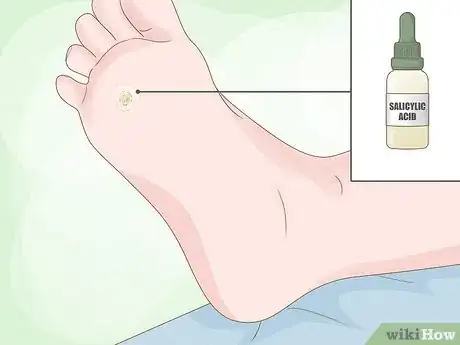

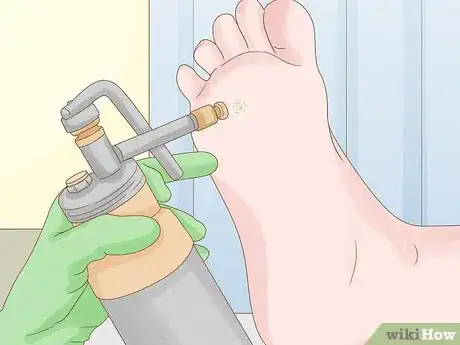
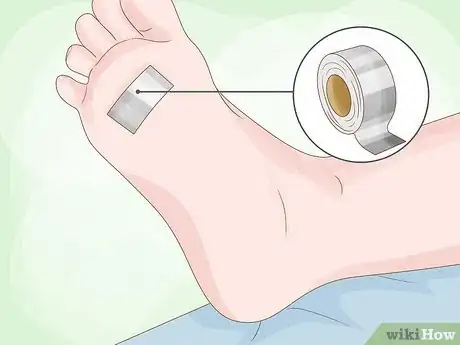
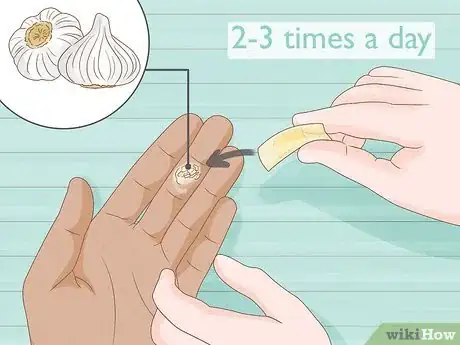
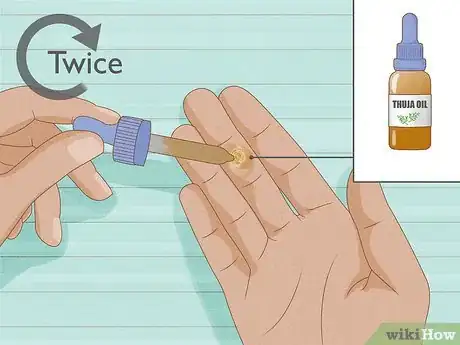
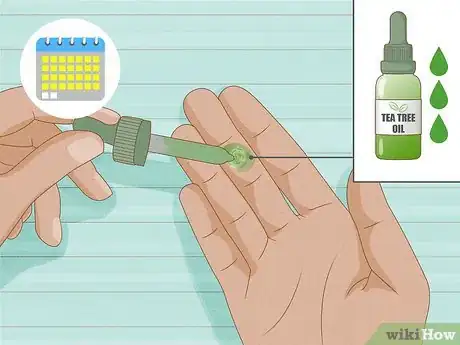
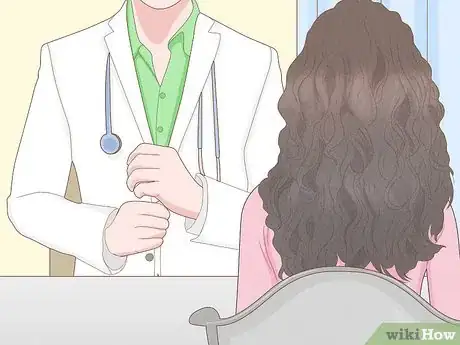
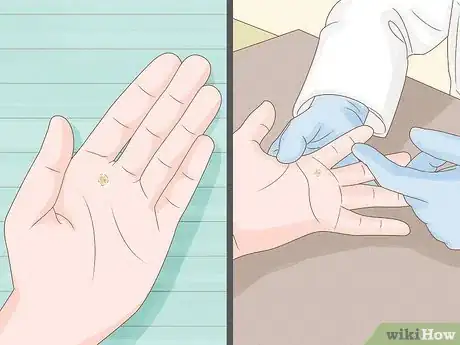
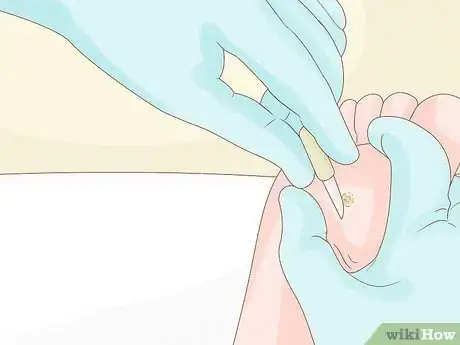

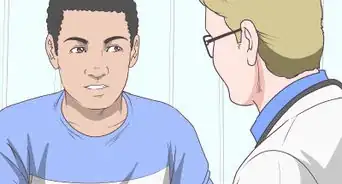
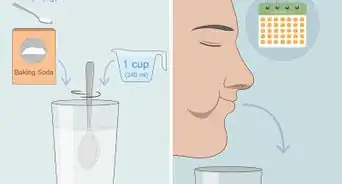
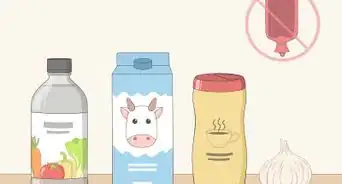
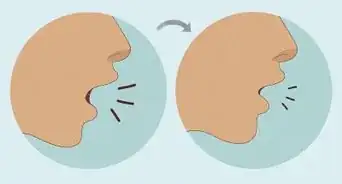

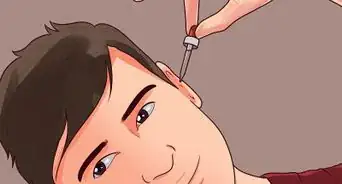




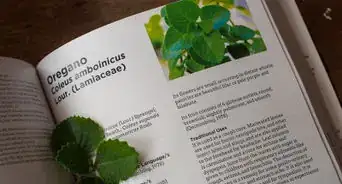
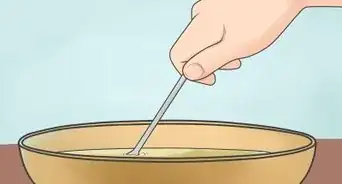
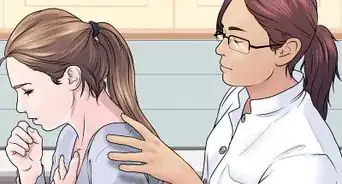






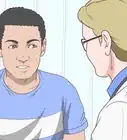
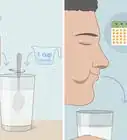





































Medical Disclaimer
The content of this article is not intended to be a substitute for professional medical advice, examination, diagnosis, or treatment. You should always contact your doctor or other qualified healthcare professional before starting, changing, or stopping any kind of health treatment.
Read More...